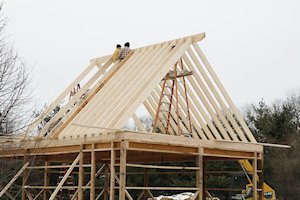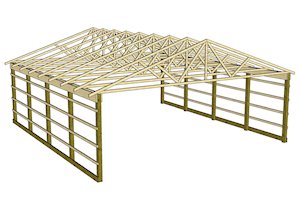How to Build Barn Roof with Rafters or Trusses
Getting ready to build a roof for your barn? See the difference between Roof Trusses and Roof Rafters.
Most of the barn roofs these days are either built with rafters or trusses. Roof rafters might be a little harder to set up, compaered to trusses, but offer much more flexibilty to construct any style or shape of loft desired. Determining what for roof construction to choose, will depend on your needs and what exactly you want to accomplish with your barn.
As with everything else, there are advantages & disadvantages for both roof constructions (see below), but, by answering few questions, you should be able to pinpoint as to the kind of roof to build and whether to go with roof truss or rafter construction.
It's Best to Use ROOF RAFTERS If:
- You want full second story or full hay loft
- You don't want hay loft, but would like extra headroom inside stalls
- You don't have good site access to get fully-built trusses delivered & set up
- You want "Cathedral" style look inside your barn without seeing bottom truss chord
It's Best to Use ROOF TRUSSES If:
- You want the least expensive way to build barn with low 4:12 roof pitch and no loft
- You want to have clear span on first floor (no loft supporting center posts)
- You are OK with limited attic space in center only. See Attic Trusses

Building Roof with RAFTERS
Unlike ordering ready-made trusses, building a rafter roof will require properly sized and pre-cut rafters. Not only you will need to be able to determine the size of material (lumber) to use based on spans between supporting headers, roof pitch and snow loads but, also to pre-cut each rafter to exact length and angle. In addition, you will need to cut out "birds mouth" of each rafter to exact size, so it seats firmly on top of rafter plate or header. For a small shed, you can try to tackle this job yourself. For a bigger project, we advise to hire an experienced contractor to cut and set up all of your roof rafters. Setting up rafters will require at least 2-3 people (depending on size of roof).
Roof Rafter Advantages:
1. Roof built with rafters can accomodate full loft.
2. When no loft is needed, roof rafters will provide more headroom and
"Cathedral style" look.
3. More flexibility to build different shape loft.
Rafters Disadvantages:
1. Slightly harder to set up for unexperinced builders.
2. In most cases, second story floor must be supported by center posts and headers.
3. Must be able to properly design and cut the rafters.

Building Roof with TRUSSES
In some cases, using trusses might simply be the best solution for your barn roof. Not only truss company will design roof trusses per your local building codes, but will also deliver and help you set them up with a crane during installation. All you have to do is find enough people to help you set up your trusses. Setting up trusses will require 4 or more people (depending on truss size). 8-12 people are needed to set up large trusses such ass indoor arena roofs.
See different types of Roof Trusses
Roof Truss Advantages:
1. Ability to have clear span floor without the use of support posts.
2. Trusses are designed and built by a truss company (less headaches for you).
3. In some cases, less expensive to build.
Truss Disadvantages:
1. Good site acess is needed for delivery.
2. Provides less attic space.
3. Bottom chord spans the whole width of barn taking away extra head room
space inside of horse stalls.
4. Requires more people to set up.
